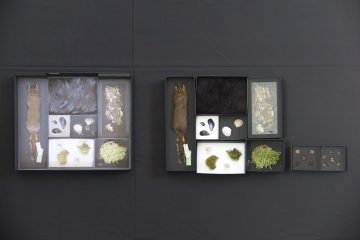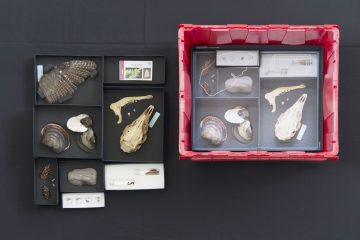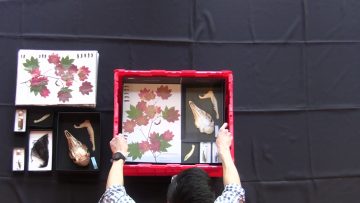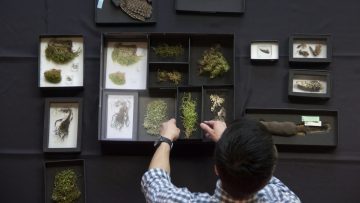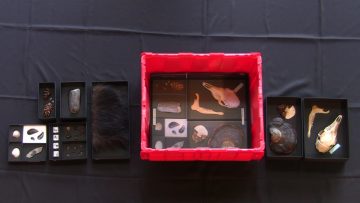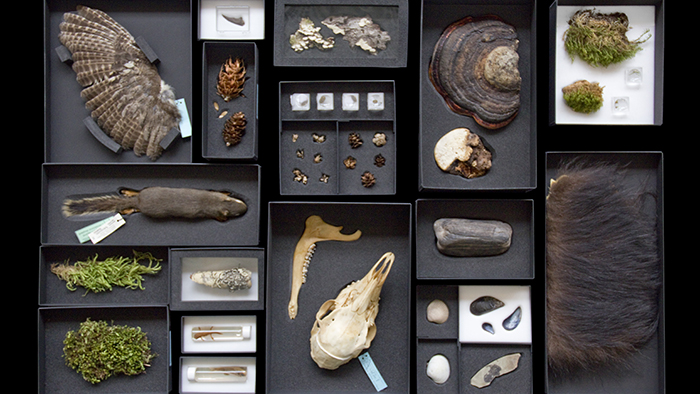
The theme for this Beaty Box is the Pacific coastal temperate rainforest, with a focus on ecological connections. Under this theme, students can learn more about:
- Making observations about forest-dwelling organisms
- Connections between living and non-living things
- The role of salmon in the temperate rainforest
By the end of the lesson, your group should feel more comfortable with the temperate forest ecosystem and the organisms living within it.
Request a Forest Box for your classroom here.
How to pack your Forest Beaty Box
Please note that while Forest Box 005 and Forest Box 006 contain the exact same specimens, they are packed differently.
Click here for a video on how to handle Beaty Box specimens.
Forest Box Dimensions:
- Length: 60.9 cm (24”)
- Width: 50 cm (19.5”)
- Height: 33 cm (13”)
- Weight: 10.4 kg (23 lbs.)
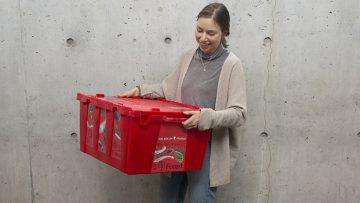
- Forest Box 006 Tray 1
- Forest Box 006 Tray 2
- Forest Box 006 Tray 3
- Forest Box 006 Tray 4
- Forest Box 005 Tray 1
- Forest Box 005 Tray 2
- Forest Box 005 Tray 3
Forest Interactions Lesson Plan
Learning Objectives: After this lesson, students should be able to:
- Identify and describe non-living characteristics and living organisms of the temperate rainforest
- Handle real museum specimens gently
- Make connections between local species in the Pacific coastal temperate rainforest
- Infer and propose connections between organisms in an ecosystem
- Discuss the role of salmon in the Pacific coastal temperate rainforest
Big Ideas & Concepts
- Science Curriculum (K-9)
- Kindergarten: Plants and animals have observable features; daily and seasonal changes affect all living things
- Grade 1: Living things have features and behaviours that help them survive in their environment; observable patterns and cycles occur in the landscape
- Grade 2: Living things have life cycles adapted to their environment; materials can be changed through physical and chemical processes; water is essential to all living things, and it cycles through the environment
- Grade 3: Living things are diverse, can be grouped, and interact in their ecosystems
- Grade 4: All living things sense and respond to their environment; matter has mass, takes up space, and can change phase; energy can be transformed; the motions of Earth and the moon cause observable patterns that affect living systems
- Grade 5: Multicellular organisms have organ systems that enable them to survive and interact within their environment; Earth materials can be used as natural resources
- Grade 6: Multicellular organisms rely on internal systems to survive, reproduce, and interact with their environment
- Grade 7: Evolution by natural selection provides an explanation for the diversity and survival of living things
- Grade 8: Life processes are performed at the cellular level
- Grade 9: Cells are derived from cells; the biosphere, geosphere, hydrosphere, and atmosphere are interconnected, as matter cycles and energy flows through them
- Connections to Secondary Curriculum (10-12)
- Grade 10: Genes are the foundation for the diversity of living things; energy is conserved and its transformation can affect living things and the environment
- Chemistry 11: Matter and energy are conserved in chemical reactions; chemical reactions and their applications have significant implications for the environment
- Earth Sciences 11: Earth materials are changed as they cycle through the geosphere and are used as resources, with environmental implication; the distribution of water has a major influence on weather and climate
- Environmental Science 11: Local environments contain diverse ecosystems with many roles and relationships; interconnected systems sustain healthy ecosystems; ecosystem stability is an important result of sustainability; humans can play a role in conservation of ecosystems
- Life Sciences 11: All living things have common characteristics; living things evolve over time; organisms are grouped on the basis of identifiable similarities
- Physics 11: Energy is found in different forms, is conserved, and has the ability to do work
- Science for Citizens 11: Science helps explain how natural changes and human choices affect global systems
- Anatomy and Physiology 12: The body strives to maintain homeostasis; all living things are made of cells, which contain DNA and cell structures that allow cells to survive and reproduce
- Environmental Science 12: Sustainable land use and food production will meet the needs of a growing population; living sustainably supports the well-being of self, community, and Earth
- Geology 12: Geologic time is preserved in Earth's rock record as fossils and reflects profound changes in the history of life on Earth
Educators Manual
- Each box comes with a comprehensive Educator Manual to provide you with all the information you need to confidently share and explore the Forest Beaty Box with your group.
- Manual includes:
- Beaty Box Basics
- Information on the specimens in the box - where they come from, how they are prepared, and information on how to handle them safely
- Information about the Beaty Biodiversity Museum
- Click here to download Beaty Box Basics
- Customized Lesson Plan and Specimen Information
- A lesson plan and list of relevant "Big Ideas" and "Core Concepts" outlined in the BC Curriculum
- Flashcards for each specimen with images and background information
- Suggestions and links to additional activities
- A USB key with a digital copy of the manual plus extra images and activities you can print off or download
- Click here to download the Forest Box Lesson Plan and Specimen Information
- Beaty Box Basics


